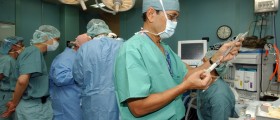Back pain is one of the most common reasons for people to go to the doctor. Very often, it can be a signal of a serious medical problem. At some point, the doctor may even suggest surgery.
Since back pain mostly affects the adult population, the average age for the surgery is from 40 to 45 years. It is more common among men than among women.
Laminectomy or open decompression is a surgical procedure of removing the back part of the vertebra that covers the spinal canal. It may be performed when the abnormality causes spinal nerve root compression that results in leg or arm pain and limitation of activity. This procedure is usually done to treat spinal stenosis or spinal arthritis to relieve the pain caused by such conditions, but it can also be used to treat various spinal abnormalities. Less common conditions requiring laminectomy include a facet cyst, fracture, and tumors.

Procedure
The patient will have to have an MRI, EKG, and complete blood count before the surgery. It is performed with the patient under general anesthesia, and the patient is usually positioned lying on the side or stomach.
The surgeon will cut in the middle of the patient’s back or neck. Surgery usually lasts from 1 to 3 hours. After laminectomy, the patient is moved to a recovery room. There is a healthcare team, and it watches the patient in case of complications from the surgery and anesthesia. The patient should expect to have some pain at first. Nurses will be there to check vital signs and help with pain control.
Pain medicine may be given orally or by injection. Most patients will remain in the hospital for one to three days after the procedure. During this period, they will be given antibiotics, intravenously in most cases, to prevent infection.
Generally, physical therapy is prescribed to the patients, and it should help them recover from the surgery. Patients themselves can speed their recovery, and they can do that by walking. They should avoid sitting or standing in one position for longer periods.
The first few days after the surgery the patients may have problems with sleeping because of different sleeping positions. The result depends on the cause of the patient’s lower back pain, but most of them can expect considerable relief from pain. Depending on the amount of walking and sitting the patient's job involves, he will probably be able to return to work within two to six weeks.
In general, it is a safe procedure, but potential complications include blood clots, infection, bleeding, nerve damage, spinal fluid leak, and unfortunately, worsening of the back pain.
- We retrospectively reviewed medical records of neurosurgical patients who underwent first-time, bilateral, 1-3 level laminectomies for degenerative lumbar disease. Patients with discectomy, complete facetectomy, and fusion were excluded.
- Five hundred patients were followed for an average of 46.79 months. Following lumbar laminectomy, patients experienced statistically significant improvement in back pain, neurogenic claudication, radiculopathy, weakness, and sensory deficits. The rate of intraoperative durotomy was 10.00%; however, 1.60% experienced a postoperative cerebrospinal fluid leak. The risk of experiencing at least one postoperative complication with a lumbar laminectomy was 5.60%.
- Seventy-two patients (14.40%) required reoperations for progression of degenerative disease over a mean of 3.40 years. The most common symptoms prior to reoperation included back pain (54.17%), radiculopathy (47.22%), weakness (18.06%), sensory deficit (15.28%), and neurogenic claudication (19.44%). The relative risk of reoperation for patients with postoperative back pain was 6.14 times higher than those without postoperative back pain (P
- When considering all-time reoperations, the lifetime risk of requiring a fusion after a lumbar laminectomy based on this study (average follow-up of 46.79 months) was 8.0%.

















Your thoughts on this
Loading...